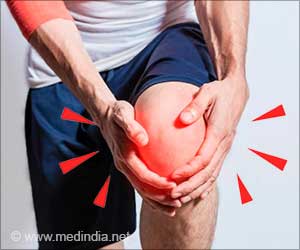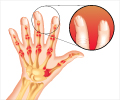Dancing molecules show promising results in promoting cartilage regeneration and joint healing in osteoarthritis patients.
- Circular TGF-β1 peptide, or "dancing molecules", enhance cartilage regeneration by improving molecular movement in osteoarthritis treatment
- These "dancing molecules" activate chondrocytes, promoting tissue repair in damaged joints
- This breakthrough approach may revolutionize osteoarthritis care by addressing cartilage degeneration, not just symptoms
Supramolecular Motion Enables Chondrogenic Bioactivity of a Cyclic Peptide Mimetic of Transforming Growth Factor-β1
Go to source).
Chondrocytes, the cells responsible for maintaining cartilage, are only found in one place in your body- inside your joints! They might just get a boost from some "dancing molecules". #medicalresearch #healthinnovation #medindia’
Role of Cartilage in Osteoarthritis
Cartilage is a connective tissue that provides cushioning for joints and helps absorb mechanical stress. In osteoarthritis, the degradation of cartilage disrupts the joint’s natural function, leading to friction between bones, which causes pain and stiffness. The key players in cartilage maintenance are chondrocytes, specialized cells that produce and maintain the extracellular matrix of cartilage. Unfortunately, in osteoarthritis, the ability of chondrocytes to repair damaged cartilage becomes impaired."Cartilage damage is a hallmark of osteoarthritis," explains Samuel I. Stupp, Ph.D., a professor at Northwestern University. "Our goal is to develop new methods to stimulate cartilage regeneration and restore joint function."
Dancing Molecules: A Game-Changer for Cartilage Repair
The recent study led by Dr. Stupp and his team focused on developing a molecular compound that combined peptide amphiphiles (PA) with a TGF-β1 mimic epitope. Mimetic epitopes are synthetic molecules that mimic the structures and functions of natural proteins. In this case, the researchers engineered a circular form of the TGF-β1 peptide, allowing for greater movement and flexibility compared to its linear counterpart.The researchers found that this circular peptide, or "dancing molecule," was more effective at activating TGF-β1 signaling in human joint chondrocytes. This increased mobility enhanced the production of cartilage-regenerating components, suggesting that the "dancing molecules" could significantly aid in cartilage repair.
"We modified the structure of the molecules to enhance their mobility," Dr. Stupp explained. "We discovered that supramolecular mobility is critical for effectively signaling cells to produce cartilage tissue components." This breakthrough demonstrates that molecular motion plays a crucial role in cartilage regeneration. The enhanced mobility of these "dancing molecules" triggers a more effective response in chondrocytes, leading to improved cartilage repair outcomes.
Potential Impact on Osteoarthritis Treatment
The implications of this study are profound. By promoting cartilage regeneration, "dancing molecules" could help reverse some of the damage caused by osteoarthritis. This marks a shift away from merely managing symptoms to addressing the underlying cause of the disease. However, it is important to note that while this research shows promise, it is still in the early stages.Currently, most osteoarthritis treatments aim to alleviate pain and improve joint function through conservative measures like physical therapy, anti-inflammatory medications, and, in severe cases, joint replacement surgery. However, these treatments do not repair the damaged cartilage itself. If "dancing molecules" can be further developed and tested in clinical trials, they could represent a revolutionary new approach to treating osteoarthritis.
Can ’Dancing Molecules’ be Commercialized for Osteoarthritis Treatment?
Despite the encouraging findings, the study does have limitations. For one, while the researchers tested the "dancing molecules" on human cartilage cells in the lab, the results have yet to be confirmed in live human subjects. As with many promising scientific discoveries, translating lab results into effective treatments for patients involves a complex and lengthy process.Dr. Stupp and his colleagues are continuing their research in this area. One recent study tested a similar bioactive substance in sheep, and the team plans to explore which bioactive compounds are the most effective for cartilage regeneration. The ultimate goal is to seek approval for clinical trials in humans, but there are still many steps to complete before that can happen.
"We need to understand how to scale up production and establish a manufacturing process that allows for commercialization," said Dr. Stupp. "Once we have the necessary data, we will approach the FDA to conduct the first clinical trials in patients."
’Dancing molecules’ Set to Revolutionize Osteoarthritis Treatment
While the research is still in its early stages, medical experts are optimistic about the potential of "dancing molecules" to revolutionize osteoarthritis treatment. Dr. Bert Mandelbaum, a sports medicine specialist and orthopedic surgeon at the Cedars-Sinai Medical Center in Los Angeles, commented on the study’s significance, "Millions of people around the world are affected by cartilage degradation, making this a significant study that opens up new possibilities. Although more systematic follow-up research is needed, especially in humans, this approach holds great potential."The growing global burden of osteoarthritis highlights the urgent need for innovative treatment options. According to the Centers for Disease Control and Prevention (CDC), 21.2% of U.S. adults have been diagnosed with some form of arthritis, including osteoarthritis. Worldwide, more than 500 million people suffer from osteoarthritis, underscoring the importance of advancing cartilage repair strategies.
Ray of Hope for Osteoarthritis Patients
This research represents an exciting step forward in the quest to develop new treatments for osteoarthritis. If further studies confirm the effectiveness of "dancing molecules" in promoting cartilage regeneration, this approach could significantly improve the quality of life for millions of people affected by osteoarthritis.Osteoarthritis is a debilitating disease that impacts the lives of many, causing pain, disability, and reduced quality of life. As noted by Dr. Jaya Sonkar, founder of JSR Health Rheumatology, osteoarthritis remains a major cause of loss in Quality-Adjusted Life Years (QALY). "There is an urgent need for innovative treatments that not only alleviate symptoms but also address the underlying causes of the disease," she said.
While additional research is needed to bring these "dancing molecules" from the lab to the clinic, this study offers hope for a future in which cartilage repair is possible and osteoarthritis becomes a more manageable condition.
The discovery of "dancing molecules" capable of promoting cartilage regeneration offers new hope for those suffering from osteoarthritis. By enhancing the movement of these molecules, researchers have unlocked a novel approach to cartilage repair, bringing us one step closer to more effective treatments for this widespread and debilitating condition. Though further research is needed, these findings provide a promising outlook on the future of osteoarthritis treatment and may ultimately lead to improved quality of life for millions of individuals worldwide.
Reference:
- Supramolecular Motion Enables Chondrogenic Bioactivity of a Cyclic Peptide Mimetic of Transforming Growth Factor-β1 - (https://pubs.acs.org/doi/10.1021/jacs.4c05170#)
Source-Medindia
















